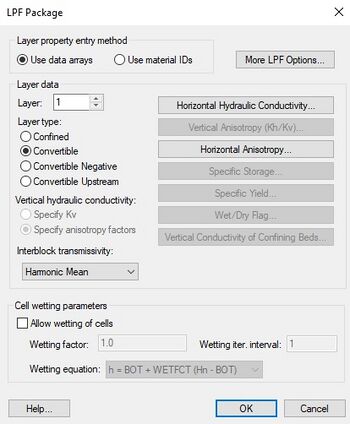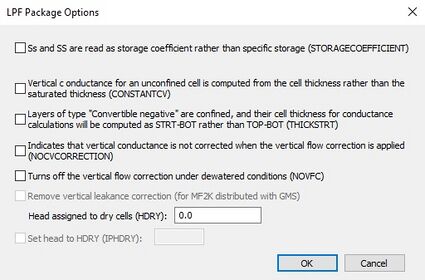GMS:LPF Package: Difference between revisions
From XMS Wiki
Jump to navigationJump to search
No edit summary |
|||
| (13 intermediate revisions by 4 users not shown) | |||
| Line 1: | Line 1: | ||
{{MODFLOW Links}} | {{MODFLOW Links}} | ||
The Layer-Property Flow (LPF) package is an alternative to the [[GMS:BCF Package|BCF]] and [[GMS:HUF Package|HUF]] packages and is similar to the "true layer" option used with the BCF package in version 3.1. With MODFLOW 2000, the layer elevations (top and bottom) are defined as input to the Global Process (using the [[GMS:Global Options/Basic Package|''Global Options'' dialog]]), regardless of which flow package is being used. With the LPF package, | The Layer-Property Flow (LPF) package is an alternative to the [[GMS:BCF Package|BCF]] and [[GMS:HUF Package|HUF]] packages and is similar to the "true layer" option used with the BCF package in version 3.1. With MODFLOW 2000, the layer elevations (top and bottom) are defined as input to the Global Process (using the [[GMS:Global Options/Basic Package|''Global Options'' dialog]]), regardless of which flow package is being used. With the LPF package, define the horizontal (K<sub>h</sub> or HK) and vertical hydraulic conductivity (K<sub>v</sub> or VK) for each layer. MODFLOW then computes the cell by cell conductances using the K values and the layer geometry. | ||
Other noteworthy features include the ability to enter horizontal anisotropy values on a cell by cell basis. There is also an option to specify vertical anisotropy factors rather than vertical hydraulic conductivity values. This option is particularly useful when performing automated parameter estimation since it ties the K<sub>v</sub> to K<sub>h</sub> and eliminates the need to define K<sub>v</sub> as an independent parameter. | Other noteworthy features include the ability to enter horizontal anisotropy values on a cell by cell basis. There is also an option to specify vertical anisotropy factors rather than vertical hydraulic conductivity values. This option is particularly useful when performing automated parameter estimation since it ties the K<sub>v</sub> to K<sub>h</sub> and eliminates the need to define K<sub>v</sub> as an independent parameter. | ||
Another feature of the LPF package relative to the BCF package is that there are now only two layer types: confined and convertible. A convertible layer is similar to the | Another feature of the LPF package relative to the BCF package is that there are now only two layer types: confined and convertible. A convertible layer is similar to the LAYCON = 2 and LAYCON = 3 types in the BCF package. The layer can be either confined or unconfined depending on the elevation of the computed water table. | ||
Once the LPF package has been chosen using the packages dialog, the ''LPF package'' dialog can be accessed through the '''LPF – Layer Property Flow | Once the LPF package has been chosen using the packages dialog, the ''LPF package'' dialog can be accessed through the '''LPF – Layer Property Flow''' command in the ''MODFLOW'' menu. | ||
[[File: | [[File:MODFLOW-LPF.png|thumb|350 px|The ''LPF Package'' dialog.]] | ||
=== Use data arrays === | === Use data arrays === | ||
This option allows entering conductivities on a layer-by-layer basis. When this option is chosen, the '''Horizontal Hyd. | This option allows entering conductivities on a layer-by-layer basis. When this option is chosen, the '''Horizontal Hyd. Conductivity''', '''Vertical Hyd. Conductivity''', '''Specific Storage''', etc. buttons will be available. | ||
=== Use material ids === | === Use material ids === | ||
This options uses material sets in the place of property arrays. Property values are entered on a material-by-material basis. When MODFLOW files are saved, GMS internally replaces the correct values from the materials to the property arrays. When this option is chose, the property array buttons are replaced with the '''Material Properties''' and '''Material IDs''' buttons. | This options uses material sets in the place of property arrays. Property values are entered on a material-by-material basis. When MODFLOW files are saved, GMS internally replaces the correct values from the materials to the property arrays. When this option is chose, the property array buttons are replaced with the [[GMS:Materials|'''Material Properties''']] and [[GMS:MODFLOW_Array_Editor#Material_ID_Legend|'''Material IDs''']] buttons. | ||
=== Layer === | === Layer === | ||
| Line 24: | Line 24: | ||
=== Layer type === | === Layer type === | ||
This radio group selects the layer type for the current layer. | This radio group selects the layer type for the current layer. There are four options, Confined, Convertible, Convertible Negative, and Convertible Upstream. By default, all layers are convertible (where the layer can be either confined or unconfined depending on the elevation of the computed water table). Here layer type can be changed to confined. Only one layer type can be assigned to each grid layer. | ||
=== Vertical hydraulic conductivity === | === Vertical hydraulic conductivity === | ||
| Line 59: | Line 59: | ||
==== Remove vertical leakance correction ==== | ==== Remove vertical leakance correction ==== | ||
This is the value that MODFLOW will give to cells with a head level below the bottom elevation of the cell (dry cell). When reading in a solution, GMS will mark cells with this value with a dry cell symbol. The Layer Property Flow Package of MODFLOW-2000 was modified by A.W. Harbaugh (U.S. Geological Survey, written commun., 2002) to remove the vertical leakage correction for conditions in which a partially saturated cell is immediately below a fully or partially saturated cell (Harbaugh and others, 2000, p. 31-33). The vertical leakage correction simulates perched conditions within an aquifer system. However, perched conditions are not known to be widespread on a basin scale. The vertical leakage correction adds an additional nonlinear term to the model (A.W. Harbaugh, U.S. Geological Survey, written commun., 2002), which resulted in several of the numerical solvers (SIP (strongly implicit procedures), SOR (slice-successive overrelaxation), and PCG (Hill, 1990; Harbaugh and others, 2000) not coming to a solution and the LMG (link-algebraic multigrid; Mehl and Hill,2001) solver providing unacceptable volumetric budget errors (wrir02-4200.pdf) . Thus in the LPF package | This is the value that MODFLOW will give to cells with a head level below the bottom elevation of the cell (dry cell). When reading in a solution, GMS will mark cells with this value with a dry cell symbol. The Layer Property Flow Package of MODFLOW-2000 was modified by A.W. Harbaugh (U.S. Geological Survey, written commun., 2002) to remove the vertical leakage correction for conditions in which a partially saturated cell is immediately below a fully or partially saturated cell (Harbaugh and others, 2000, p. 31-33). The vertical leakage correction simulates perched conditions within an aquifer system. However, perched conditions are not known to be widespread on a basin scale. The vertical leakage correction adds an additional nonlinear term to the model (A.W. Harbaugh, U.S. Geological Survey, written commun., 2002), which resulted in several of the numerical solvers (SIP (strongly implicit procedures), SOR (slice-successive overrelaxation), and PCG (Hill, 1990; Harbaugh and others, 2000) not coming to a solution and the LMG (link-algebraic multigrid; Mehl and Hill,2001) solver providing unacceptable volumetric budget errors (wrir02-4200.pdf) . Thus in the LPF package there is the option to turn off the vertical leakance correction to account for these factors. After turning on the ''Remove Vertical Leakance Correction'' toggle, GMS then uses the [http://water.usgs.gov/nrp/gwsoftware/modflow2000/MFDOC/index.html?lpf.htm NOCVCORRCTION] option that is found in MODFLOW2005 to remove vertical leakance corrections. | ||
==== Head Assigned to Dry Cells ==== | ==== Head Assigned to Dry Cells ==== | ||
| Line 73: | Line 73: | ||
[[Category:MODFLOW Packages]] | [[Category:MODFLOW Packages]] | ||
[[Category:MODFLOW Dialogs]] | [[Category:MODFLOW Dialogs]] | ||
[[Category:MODFLOW-USG]] | |||
[[Category:External Links]] | [[Category:External Links]] | ||

